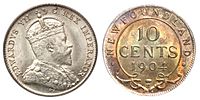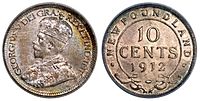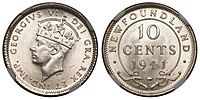Newfoundland ten cents facts for kids
The Newfoundland ten cent coins are special pieces of history from Newfoundland. These coins have a front side, called the obverse, and a back side, called the reverse. The design for the front of these coins was first used for coins from New Brunswick. This is similar to how the Newfoundland five cent coins were designed.
Contents
Queen Victoria's Coins (1865-1896)
The ten-cent coins featuring Queen Victoria on the front have three slightly different designs. These small differences help collectors tell them apart.
Victoria Coin Varieties
The first type of Queen Victoria coin was made in 1865, 1870, and 1873. On these coins, the laurel crown (a wreath of leaves) on Queen Victoria's head has two leaves at the very top. Also, you can spot two small dots before and after the word "Newfoundland" on the front of the coin.
The second type of coin has three leaves at the top of the laurel crown. For these coins, there is only one dot before the word "Newfoundland" on the front, but no dot after it. You can find this design on coins from 1870, 1872H, 1873, 1876H, 1880, 1885, and 1894.
The third type is like the first, with two leaves at the top of the laurel crown. The main difference is that one of these leaves barely touches the band of words around the edge of the coin. This design was used for coins made in 1882H, 1885, 1888, 1890, 1894, and 1896.
Coin Details for Queen Victoria (1865-1896)
Here are some facts about these coins:
| Designer | Engraver | What it's made of | Weight | Diameter |
|---|---|---|---|---|
| Leonard C. Wyon | Leonard C. Wyon | .925 silver, .075 copper | 2.36 grams | 17.98 mm |
How Many Were Made (Queen Victoria)
This table shows how many of each Queen Victoria ten-cent coin were made:
| Date and Mint Mark | Number Made |
|---|---|
| 1865 | 80,000 |
| 1870 | 30,000 |
| 1872 | 40,000 (part of 1871 coins) |
| 1873 | 23,614 |
| 1876H | 10,000 |
| 1880 | 10,000 |
| 1882H | 20,000 |
| 1885 | 8,000 |
| 1888 | 30,000 |
| 1890 | 100,000 |
| 1894 | 100,000 |
| 1896 | 230,000 |
The Rare 1871 "Mule" Coin
A very rare type of coin exists from 1871. It's called a "mule" coin. A mule coin happens when the front (obverse) and back (reverse) parts of the coin are from different designs that were not meant to be used together. For this coin, an 1871H Newfoundland front was accidentally paired with an 1871H Canada back.
Number of 1871 Mule Coins
Only a small number of these rare coins were made:
| Date and Mint Mark | Number Made |
|---|---|
| 1871H | 40,000 |
King Edward VII's Coins (1903-1904)
The front of the ten-cent coins featuring King Edward VII was the same as the coins used in Canada at the time. The back of the coin, however, had a brand new design created by George W. DeSaulles.
Coin Details for King Edward VII (1903-1904)
Here are the specifications for these coins:
| Designer | Engraver | What it's made of | Weight | Diameter |
|---|---|---|---|---|
| George W. DeSaulles | George W. DeSaulles | .925 silver, .075 copper | 2.36 grams | 17.96 mm |
How Many Were Made (King Edward VII)
This table shows how many King Edward VII ten-cent coins were made:
| Date and Mint Mark | Number Made |
|---|---|
| 1903 | 100,000 |
| 1904H | 100,000 |
King George V's Coins (1912-1919)
The front of the ten-cent coins with King George V was also the same as the Canadian coins of that period. The back of the coin continued to use the design from the earlier King Edward VII Newfoundland coins.
Coin Details for King George V (1912-1919)
Here are the specifications for these coins:
| Designer | Engraver | What it's made of | Weight (1912–1917) | Weight (1919) | Diameter (1912) | Diameter (1917–1919) |
|---|---|---|---|---|---|---|
| Sir E.B. MacKennal | George W. DeSaulles | .925 silver, .075 copper | 2.36 grams | 2.33 grams | 17.96 mm | 18.03 mm |
How Many Were Made (King George V)
This table shows how many King George V ten-cent coins were made:
| Date and Mint Mark | Number Made |
|---|---|
| 1912 | 150,000 |
| 1917C | 250,805 |
| 1919C | 54,342 |
King George VI's Coins (1938-1947)
For the ten-cent coins featuring King George VI, the front used a standard portrait of the King designed by Percy Metcalfe. This portrait was also used on other British colonial coins. The back of the coin kept the same design from the earlier Edward VII and George V coins.
Some of the numbers for how many coins were made in 1946 and 1947 are not officially recorded. This also happened with the Newfoundland five cents coins from that time. Even though official reports don't show any ten-cent coins made in 1946, it seems some 1946 coins were actually created in 1947. Because of this, the numbers for 1946 and 1947 are considered unofficial.
Coin Details for King George VI (1938-1947)
Here are the specifications for these coins:
| Designer | Engraver | What it's made of (1938–1944) | What it's made of (1945–1947) | Weight | Diameter |
|---|---|---|---|---|---|
| Percy Metcalfe | George W. DeSaulles | .925 silver, .075 copper | .800 silver, .200 copper | 2.36 grams | 18.03 mm |
How Many Were Made (King George VI)
This table shows how many King George VI ten-cent coins were made:
| Date and Mint Mark | Number Made |
|---|---|
| 1938 | 100,000 |
| 1940 | 100,000 |
| 1941C | 483,630 |
| 1942C | 292,736 |
| 1943C | 104,706 |
| 1944C | 151,471 |
| 1945C | 175,833 |
| 1946C | 38,400 |
| 1947C | 61,988 |





